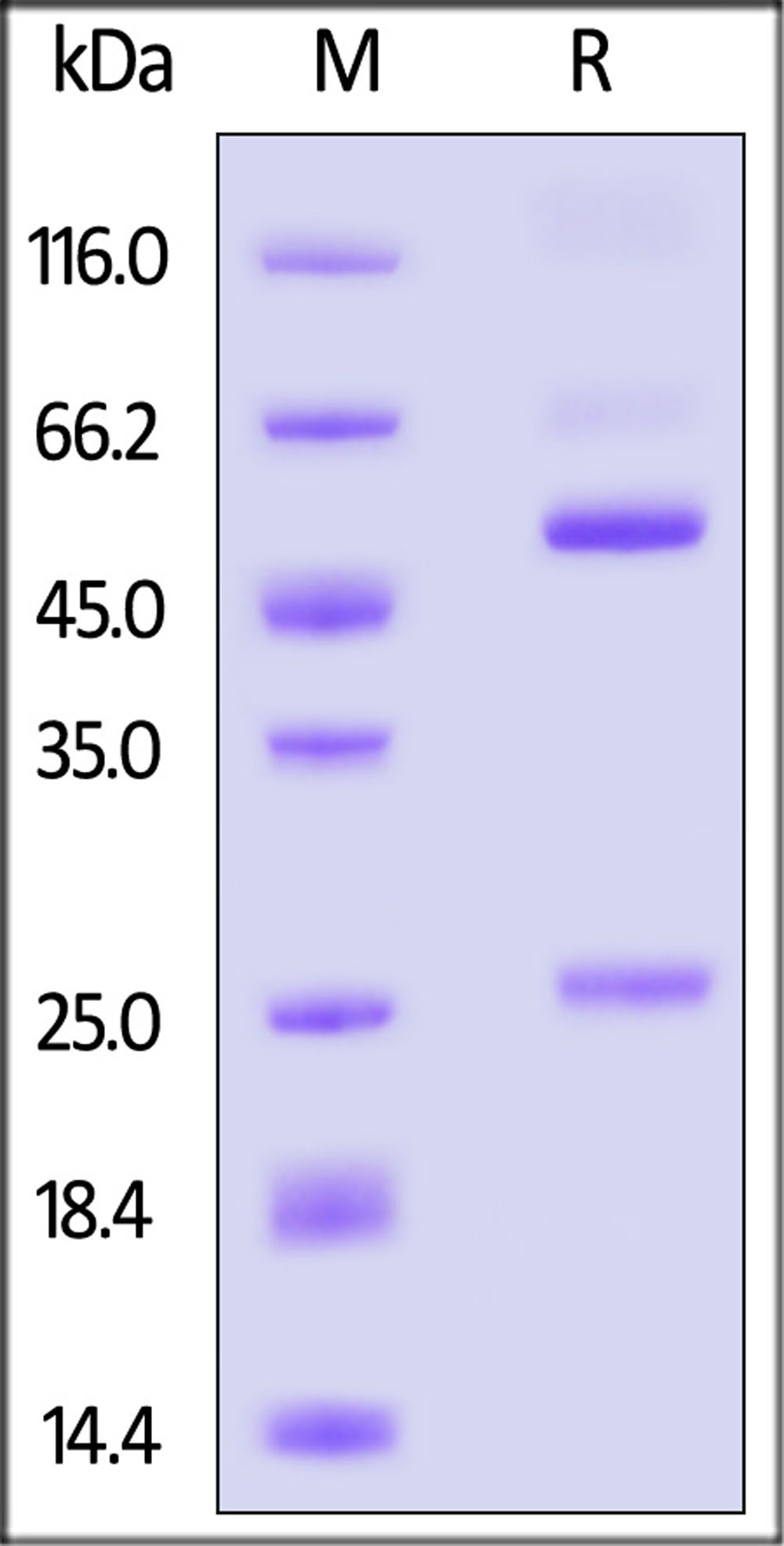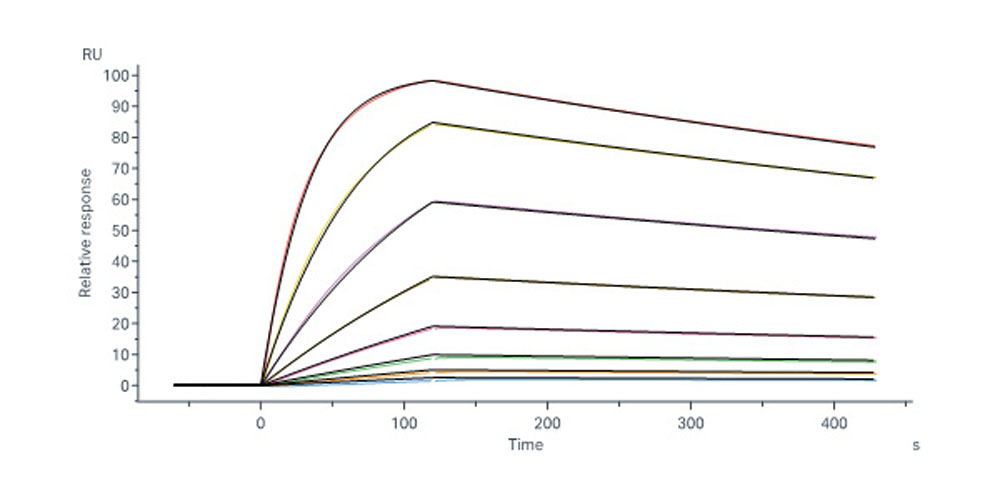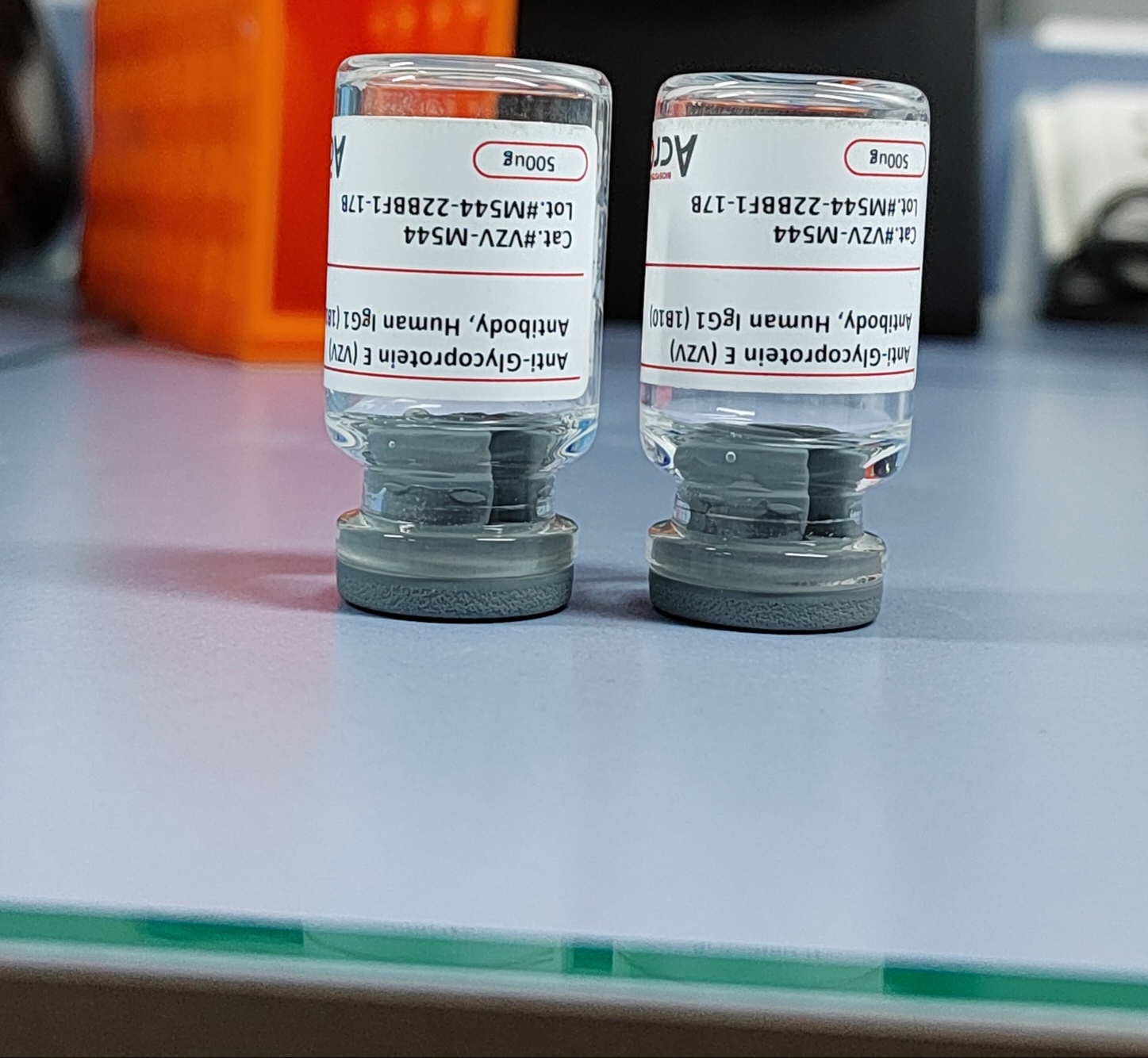抗体来源(Source)
Anti-Glycoprotein E (VZV) Antibody, Human IgG1 (1B10) is a chimeric monoclonal antibody recombinantly expressed from HEK293, which combines the variable region of a mouse monoclonal antibody with Human constant domain.
克隆号(Clone)
1B10
亚型(Isotype)
Human IgG1 | Human Kappa
偶联(Conjugate)
Unconjugated
抗体类型(Antibody Type)
Recombinant Monoclonal
种属反应性(Reactivity)
Virus
免疫原(Immunogen)
Recombinant Varicella zoster virus (strain Oka vaccine) Envelope Glycoprotein E (gE) derived from human 293 cells.
特异性(Specificity)
This product is a specific antibody specifically reacts with Glycoprotein E/gE (VZV).
应用(Application)
| Application | Recommended Usage |
| ELISA | 0.1-8 ng/mL |
纯度(Purity)
>90% as determined by SDS-PAGE.
>95% as determined by SEC-MALS.
纯化(Purification)
Protein A purified / Protein G purified
制剂(Formulation)
Lyophilized from 0.22 μm filtered solution in PBS, pH7.4 with trehalose as protectant.
Contact us for customized product form or formulation.
重构方法(Reconstitution)
Please see Certificate of Analysis for specific instructions.
For best performance, we strongly recommend you to follow the reconstitution protocol provided in the CoA.
存储(Storage)
For long term storage, the product should be stored at lyophilized state at -20°C or lower.
Please avoid repeated freeze-thaw cycles.
This product is stable after storage at:
- -20°C to -70°C for 12 months in lyophilized state;
- -70°C for 3 months under sterile conditions after reconstitution.
质量管理控制体系(QMS)
电泳(SDS-PAGE)

Anti-Glycoprotein E (VZV) Antibody, Human IgG1 (1B10) on SDS-PAGE under reducing (R) condition. The gel was stained with Coomassie Blue. The purity of the protein is greater than 90%.
SEC-MALS

The purity of Anti-Glycoprotein E (VZV) Antibody, Human IgG1 (1B10) (Cat. No. VZV-M544) is more than 95% and the molecular weight of this protein is around 135-155 kDa verified by SEC-MALS.
Report
活性(Bioactivity)-ELISA

Immobilized Varicella zoster virus (strain Oka vaccine) Envelope Glycoprotein E (gE), His Tag (Cat. No. GLE-V52H3) at 1 μg/mL (100 μL/well) can bind Anti-Glycoprotein E (VZV) Antibody, Human IgG1 (1B10) (Cat. No. VZV-M544) with a linear range of 0.1-1 ng/mL (QC tested).
Protocol

Immobilized Varicella zoster virus (strain Oka vaccine) Envelope Glycoprotein E (gE), His Tag (Cat. No. GLE-V52H3) on Anti-Glycoprotein E (VZV) Antibody, Human IgG1 (1B10) (Cat. No. VZV-M544) precoated (0.2 μg/well) plate can bind Biotinylated Monoclonal Anti-Glycoprotein E (VZV) Antibody, Human IgG1 (4G2) (Cat. No. VZV-BLM545)at 0.25 μg/mL (100 μL/well) with a linear range of 0.2-8 ng/mL (Routinely tested).
Protocol
活性(Bioactivity)-SPR

Anti-Glycoprotein E (VZV) Antibody, Human IgG1 (1B10) (Cat. No. VZV-M544) captured on Protein A Chip can bind Varicella zoster virus (strain Oka vaccine) Envelope Glycoprotein E (gE), His Tag (Cat. No. GLE-V52H3) with an affinity constant of 5.63 nM as determined in SPR assay (Biacore 8K) (Routinely tested).
Protocol
 +添加评论
+添加评论背景(Background)
Varicella-zoster virus (VZV) is a neurotropic virus belonging to the Herpesviridae family. Primary VZV infection causes chickenpox and is followed by a life-long latent infection established mainly in the cranial and dorsal root ganglia. Reactivation of the virus is often associated with shingles (herpes zoster).
Glycoprotein E (gE) is one of the known glycoproteins (gB, gC, gE, gH, gI, gK, gI) of VZV that is most abundantly expressed on the surface of virus and infected cells, playing an important role in viral replication and cell-to-cell spread. The strongly immunogenic gE can provide strong IgG signal in body fluid, which makes it ideal to be developed as an antigen for analysis of IgG antibodies. gE also demonstrates high potency as a vaccine immunogen and is formulated as the single viral envelope protein that constitutes the GSK VZV recombinant subunit vaccine Shingrix®.























































 膜杰作
膜杰作 Star Staining
Star Staining


















